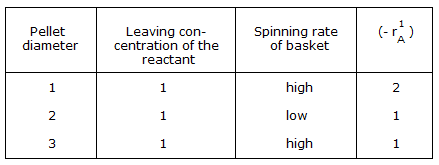Chemical Engineering :: Chemical Reaction Engineering
-
For a first order isothermal chemical reaction in a porous catalyst, the effectiveness factor is 0.3. The effectiveness factor will increase if the
-
Cold shot cooling is only practical when the feed temperature is __________ than the reaction temperature.
-
The following gas phase reaction is taking place in a plug flow reactor.

A stoichiometric mixture of A and B at 300 K is fed to the reactor. At 1 m along the length of the reactor, the temperature is 360 K. The pressure drop is negligible and an ideal gas behaviour can be assumed. Identify the correct expression relating the concentration of A at the inlet (CA0), concentration of A at 1m (CA) and the corresponding conversion of A (X). -
The preferred reacting system for oxidation of o-xylene to phthalic anhydride is
-
The effectiveness factor for large value of Thiele modulus (LK/D1) of a solid catalysed first order reaction is equal to (where, L = length of the reactor, cm, D1 = diffusion co-efficient, cm2/second)
-
A first order reaction A
 B occurs in an isothermal porous catalyst pellet of spherical shape. If the concentration of A at the centre of the pellet is much less than at the external surface, the process is limited by
B occurs in an isothermal porous catalyst pellet of spherical shape. If the concentration of A at the centre of the pellet is much less than at the external surface, the process is limited by -
Following isothermal kinetic data are obtained in a basket type of mixed flow reactor for a porous catalyst. Determine the role of pore diffusion and external mass transfer processes.



 Whatsapp
Whatsapp
 Facebook
Facebook





